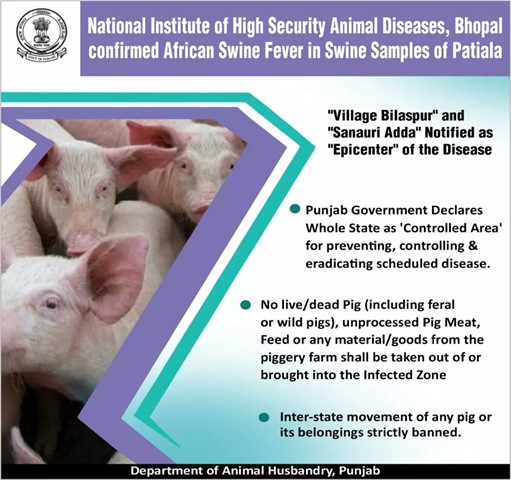- Courses
- GS Full Course 1 Year
- GS Full Course 2 Year
- GS Full Course 3 Year
- GS Full Course Till Selection
- Answer Alpha: Mains 2025 Mentorship
- MEP (Mains Enrichment Programme) Data, Facts
- Essay Target – 150+ Marks
- Online Program
- GS Recorded Course
- Polity
- Geography
- Economy
- Ancient, Medieval and Art & Culture AMAC
- Modern India, Post Independence & World History
- Environment
- Governance
- Science & Technology
- International Relations and Internal Security
- Disaster Management
- Ethics
- Current Affairs
- Indian Society and Social Issue
- NCERT- Science and Technology
- NCERT - Geography
- NCERT - Ancient History
- NCERT- World History
- CSAT
- 5 LAYERED ARJUNA Mentorship
- Public Administration Optional
- ABOUT US
- OUR TOPPERS
- TEST SERIES
- FREE STUDY MATERIAL
- VIDEOS
- CONTACT US
AFRICAN SWINE FEVER AND PYGMY HOGS
AFRICAN SWINE FEVER AND PYGMY HOGS


Latest Context
According to an article published in the journal ‘Science’, the African Swine Fever threatens India’s Pygmy Hog and other Asian wild pig species. It is the world’s rarest and smallest pigs.
Key Points of African Swine Fever
-
It was first detected in Kenya (Africa) in 1921, and it has spread to many countries in Africa, Europe, and Asia.
-
Mortality rate is 95% - 100%, and it has no cure.
-
It listed in the World Organisation for Animal Health (OIE)’s Terrestrial Animal Health Code.
-
It is caused by a virus that belongs to the Asfarviridae family.
-
It is highly contagious and can spread rapidly within pig populations through direct contact between infected and healthy pigs, as well as through contact with contaminated objects and feed.
Characteristics of Pygmy Hog
-
Scientific Name: Porcula Salvania
-
Features: Pygmy hogs are the smallest wild pig species in the world.
-
Habitat: Pygmy hogs are found in grasslands, swamps, and riverine forests in the foothills of the Himalayas. They prefer areas with dense grass cover and access to water. In India, it is found only in Assam.
-
Protection Status:
-
IUCN Red List: Critically Endangered
-
CITES: Appendix I
-
Wildlife (Protection) Act, 1972: Schedule I
-
Threats: Due to loss of habitat, illegal hunting and degradation.
-
Conservation Status: - Captive breeding and habitat restoration programs are underway to save the species.
-
Between 2011 and 2015 animals were reintroduced into the Orang National Park
-
PHCP plans to release 60 pygmy hogs in Manas National Park.




